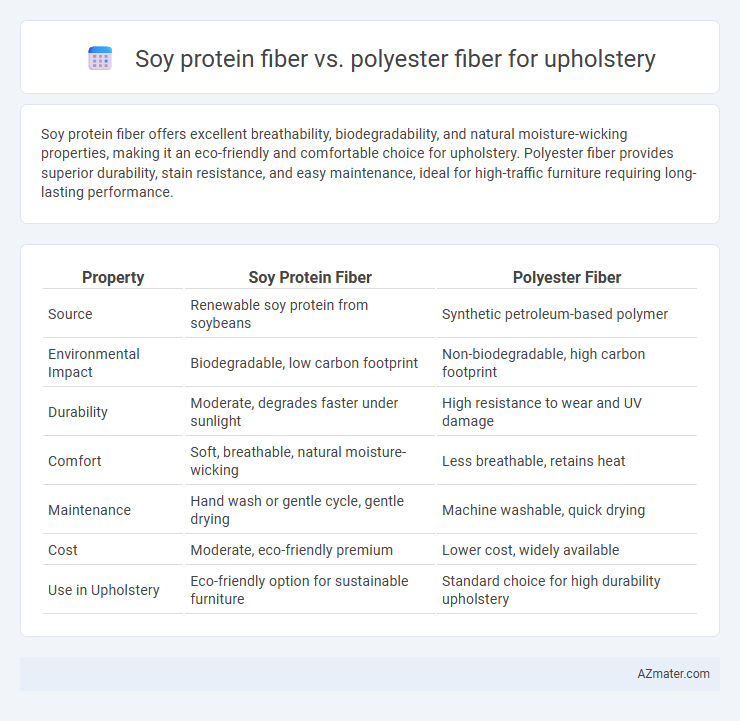Soy protein fiber offers excellent breathability, biodegradability, and natural moisture-wicking properties, making it an eco-friendly and comfortable choice for upholstery. Polyester fiber provides superior durability, stain resistance, and easy maintenance, ideal for high-traffic furniture requiring long-lasting performance.
Table of Comparison
| Property | Soy Protein Fiber | Polyester Fiber |
|---|---|---|
| Source | Renewable soy protein from soybeans | Synthetic petroleum-based polymer |
| Environmental Impact | Biodegradable, low carbon footprint | Non-biodegradable, high carbon footprint |
| Durability | Moderate, degrades faster under sunlight | High resistance to wear and UV damage |
| Comfort | Soft, breathable, natural moisture-wicking | Less breathable, retains heat |
| Maintenance | Hand wash or gentle cycle, gentle drying | Machine washable, quick drying |
| Cost | Moderate, eco-friendly premium | Lower cost, widely available |
| Use in Upholstery | Eco-friendly option for sustainable furniture | Standard choice for high durability upholstery |
Introduction to Upholstery Materials
Soy protein fiber is an eco-friendly upholstery material derived from renewable soybean sources, offering biodegradability, breathability, and natural softness, making it a sustainable alternative to synthetic fibers. Polyester fiber, a widely used synthetic upholstery fabric made from petroleum-based polymers, provides durability, resistance to stains and wrinkles, and cost-effectiveness but lacks biodegradability and environmental benefits. Choosing between soy protein fiber and polyester fibers depends on priorities such as environmental impact, comfort, and longevity for upholstery applications.
What is Soy Protein Fiber?
Soy protein fiber is a natural, biodegradable fiber derived from the byproducts of soybean processing, offering a sustainable alternative to synthetic materials like polyester fiber. It boasts excellent moisture absorption, breathability, and soft texture, making it suitable for upholstery that requires comfort and eco-friendliness. Compared to polyester fiber, soy protein fiber provides better temperature regulation and reduced environmental impact, aligning with green manufacturing practices.
What is Polyester Fiber?
Polyester fiber is a synthetic material made from petrochemical polymers, known for its high durability, resistance to stretching and shrinking, and quick-drying properties, making it a popular choice for upholstery fabrics. Compared to soy protein fiber, which is a natural and biodegradable fiber derived from soybeans, polyester fibers offer superior strength and abrasion resistance but lack eco-friendly attributes. Upholstery made with polyester fiber often provides longer-lasting performance and easier maintenance, though it may compromise breathability and environmental sustainability.
Comparative Durability: Soy Protein Fiber vs. Polyester
Soy protein fiber exhibits moderate durability with natural resistance to wear but is more prone to moisture absorption and degradation over time compared to polyester fiber. Polyester fiber offers superior durability, characterized by high tensile strength, excellent abrasion resistance, and minimal moisture retention, making it ideal for upholstery subjected to heavy use. The synthetic nature of polyester ensures longer lifespan and structural integrity, especially in environments with frequent cleaning or exposure to sunlight.
Comfort and Texture Differences
Soy protein fiber offers a soft, natural feel with excellent breathability, enhancing comfort in upholstery by regulating temperature and reducing moisture buildup. Polyester fiber, while durable and resistant to wrinkles, tends to feel less breathable and may trap heat, potentially leading to discomfort during extended use. The texture of soy protein fiber is smoother and more akin to natural fibers, whereas polyester often feels synthetic and slightly slick.
Environmental Impact and Sustainability
Soy protein fiber is biodegradable and renewable, derived from soybeans, reducing reliance on fossil fuels and minimizing environmental pollution. Polyester fiber, primarily made from petroleum-based materials, contributes significantly to microplastic pollution and has a higher carbon footprint due to non-renewable resource extraction. Choosing soy protein fiber for upholstery supports sustainable textile production with lower greenhouse gas emissions and enhanced end-of-life compostability.
Allergenicity and Health Considerations
Soy protein fiber, derived from natural soybean proteins, is hypoallergenic and biodegradable, reducing the risk of skin irritation and allergic reactions in upholstery applications. Polyester fiber, a synthetic material, may release volatile organic compounds (VOCs) and retain dust mites, potentially triggering allergies and respiratory issues. Choosing soy protein fiber enhances indoor air quality and promotes safer, healthier environments for sensitive individuals.
Cost Analysis: Soy Protein vs. Polyester
Soy protein fiber upholstery typically costs more upfront due to its natural, sustainable sourcing and limited production scale compared to mass-produced polyester fiber. While polyester fiber offers a lower initial price and widespread availability, soy protein fiber may provide long-term value through biodegradability and reduced environmental impact. Cost analysis must balance the immediate savings of polyester with potential sustainability benefits and durability factors of soy protein fiber.
Aesthetic and Design Versatility
Soy protein fiber offers a natural matte finish and a soft, breathable texture, enhancing upholstery with an eco-friendly and organic aesthetic. Polyester fiber provides a wide range of vibrant colors and patterns due to its synthetic composition, allowing designers greater flexibility in achieving sleek, modern looks. The inherent elasticity of polyester supports intricate weaving techniques, while soy protein fiber appeals to clients prioritizing sustainable and hypoallergenic materials for interior design.
Conclusion: Which Fiber Suits Your Upholstery Needs?
Soy protein fiber offers superior breathability, natural moisture-wicking, and biodegradability, making it an eco-friendly and comfortable choice for upholstery. Polyester fiber provides enhanced durability, stain resistance, and color retention, ideal for high-traffic areas demanding long-lasting performance. Choosing between soy protein and polyester fibers depends on whether sustainability and comfort or durability and ease of maintenance are your upholstery priorities.

Infographic: Soy protein fiber vs Polyester fiber for Upholstery
 azmater.com
azmater.com